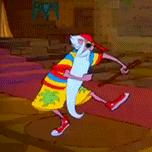Lmao.
I’ll try to explain, I guess (in a simplified manner so nerds don’t @ me).
Firstly, there’s the Bowler. That’s the pitcher in baseball, except the Bowler runs for a few seconds with the ball towards the batsman/batswoman (batter in baseball - we really should adopt that terminology) before “pitching” the ball. Thats why the arrow is there above the Bowler - toe represent that “run up”.
How much the bowler runs differs on various factors I won’t get into but it’s always from somewhere in the lighter green area to the very bottom yellowish area. The longer the “run up”, the faster the “pitch” (called delivery in cricket).
The lighter green area is the 30 yard circle. The yellowish area is the pitch. The darker green area can vary in size. It can be squarish or circle or oval. It can be 60 yards away at some stadiums or 90 yards away at others.
Usually, you’re only allowed to have a certain number of players inside the 30 yard circle, with the rest outside it. Or vice versa. I won’t get into it.
On the pitch, the light blue dot is the UMP - the umpire or the referee. There are two of them on the ground. The other stands in the 30 yard circle. (SL-UMP). The opposing team has two players on the field at a given team. Both on the pitch. They are the Batsman/Batswoman (BS and B-NS).
WK is the Wicketkeeper. Like the bowler, their position also varies. They can be close to the pitch or further away from it, usually depending on how long a run up the bowler has. But also always within the 30 yard circle.
Thats everything for the acronyms I believe.
I’ll come to the positions the fielding team (the non-batting team) takes. You only need to know a few - the rest are variations or super rare.
Firstly, the field is divided into two halves. When the batsman/batswoman hits the ball to the left half of the field, it’s considered the “leg side”. The right side is called the “off side”. This is from their point of view, not ours.
This is why as you look at the fields you’ll see positions on one side of the map, the left, have “leg” and the other, the right, had “off.”
Of course, because the right side is “off side” the left side positions that mirror them are called “on” instead of “leg” - “mid on” and “mid off” instead of “mid off” and “mid leg”.
But the left side is “leg”. It’s not “on.”
Finally, on to the positions.
The positions near the WK are the Slips. Those are the numbers. Only 1-4 are important. I didn’t even know they went up to 9. The slips are on the right side of the batter (I’m just gonna say this from now on.) Of course, when they are on the left, we say… leg slip. There is also Gully, which is also behind the batter like the Slips and the WK, but not as close as them (but still within the 30yard circle).
Positions in and on the 30 yard circle: You only need to know a few. Point, Square Leg, Cover, Mid-Wicket. If you look at the graph, you see they form a sort of square around the batter. There are four very important positions and you always have a fielder either on those potions or on one of their variations.
Which is what most of the list is!!!
Point is a position on the 30 yard circle. Deep Point is just the point fielder moving further away from the batter (beyond the 30 yard circle and closer to the edge of the field). Silly Point is the fielder moving closer to the batter, closer to the slips. Forward Point is just the fielder moving a bit lower on the 30 yard circle so they’re not parallel to the batter anymore. Backward Point is then the fielder moving up on the 30 yard circle.
What is Cover Point? Just a position between Cover and Point! (Very important btw).
What is Short Cover? Cover, but closer to the batter. Deep Cover? It’s Cover, but further away from the batter (beyond the 30-years circle). Extra Cover is Cover, but lower on the 30 yard circle. Deep Extra Cover is Extra Cover, but further away from the batter.
The graph is cut up and doesn’t show all the positions/names but it’s the same with Square Leg and its variations - Deep Square Leg, Forward Square Leg, Backward Square Leg, Deep Backward Square Leg etc. and with Mid-Wicket and Deep Midwicket.
Outside the 30-yard circle: Just four positions, again. Third Man, Fine Leg (both behind the batter) and Long On and Long Off (in front). They are all positions behind the 30 yard circle, closer to the edge of the field (the boundary). But again, there are variations.
Third Man and Fine Leg can be closer to the batter. Thus, Short Third Man or Short Fine Leg.
The Long Off and Long On have counterparts within the 30 yard circle, the Mid Off and Mid On. When these positions are instead on the 30 yard circle, they are Deep Mid Off and Deep Mid On. If they are close to the bowler when they finish the run up, they are Short Mid On and Short Mid Off. If they are even closer, ie next to the batter like with Silly Point, they are Silly Mid On and Silly Mid Off.
Finally, no one uses Straight Hit or Long Stop. But…straight, wide, fine and square are used in variations I haven’t mentioned. The gist of that is - when the Longs are closer to Straight Hit they are considered Straighter. When they are further away (and closer to deep cover/midwicket in a sense) they are Wider. Similarly, when Third Man is closer to Long Stop, they are “fine”. When they are closer to deep square, they are “square”. Of course, you can’t have a fine fine leg when you want a fielder nearer to long stop, so you say it’s a straight fine leg instead. And if it’s closer to Deep Square Leg, it is, of course, a square fine leg.
That’s it.
Hope it helps.
It's the amount of info more than the info itself, I'm sure it's perfectly understandable if you have played the sport.
That was hilarious. While the words were gibberish, the tone of the commentary was perfect classic test cricket. As were the sweaters the “players” wore. And, to be fair, the non-gibberish sentences the commentator spoke.
I guess I tried to explain the diagram as simply as possible, for me. But I cannot know if anyone actually understood it lol. That I’ll only know if someone who doesn’t know cricket (ie the vast majority of this site) reads the comment and uses it as a way to understand the positions.
I found a YouTube link in your comment. Here are links to the same video on alternative frontends that protect your privacy:
I couldn't help laughing because the explanation just kept going.
I can sincerely say that it is easier to understand how an MRI or CT scan works.
They call it that cause that's where you're most likely to get hit with a cricket ball.
I buy it, you could make similarly complex graphics/maps for american football. the defenders probably have to memorize the positions they need to take for each individual batsman before the game. It probably changes based off of game situation as well.
True, I could make a big complicated list of all the different soccer positions, like trequartista, double pivot, wing-back and so on, but this is still pretty amazing
Making catches at mid-off to long-off, and mid on to long on, is pretty satisfying.
I can appreciate that it is bad to get kicked in the head, but that also it looks cool.
I usually shop online now. But a million years ago when I was still using brick and mortar stores - I went to the mall to buy sneakers. To make a sale the sales guy was pretend-friendly and he asked what kind of sports I liked. I should have smiled and said "I'm not into sports," because pretend-friendly stuff isn't my thing. But instead without thinking I said "MMA". And he instantly replied by saying "Who's your favorite fighter?" He said it so fast he squashed it down all of that to be about a second.
I wanted to say "I just like KOs." but he would have thought I was weirdo so I said "GSP." I fucking hated GSP and his lay-and-pray stuff. But he was the first name I thought of so I said it.
Ah, so this is what XY coordinates looked like before the metric system.
Yes it's real. Though quite a few of fielding positions are never used in the modern game.
Source: I used to play cricket cricket
Not really, if you're fielding, your job is to try catch the ball hit by the batsman to get them out, or to stop it from reaching the end of the field and then throw it back to the bowler or wicketkeeper at the wickets, or directly at the wickets to run them out. It's not that complicated, if you think you can reach the ball hit by the batsman you call for it and try catch or stop it.
It's the captain and the coaching staff that sets the positions of the fielders, now that is complicated strategy.
















